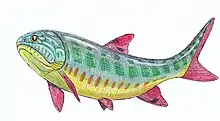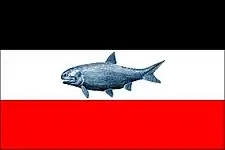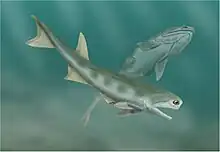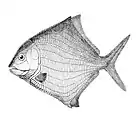Acrolepis
Acrolepis (Ancient Greek for "tip scale") is an extinct genus of prehistoric bony fish that lived from the Tournaisian stage of the Mississippian (early Carboniferous) to the late Permian epoch.[1] Some species from the Early Triassic of Tasmania are also ascribed to Acrolepis.[2]
| Acrolepis Temporal range: | |
|---|---|
 | |
| Fossil of Acrolepis sedgwicki | |
 | |
| Restoration | |
| Scientific classification | |
| Kingdom: | |
| Phylum: | |
| Class: | |
| Order: | |
| Family: | |
| Genus: | †Acrolepis Agassiz, 1843 |
| Type species | |
| †Acrolepis sedgwicki Agassiz, 1843 | |
| Other species | |
| |
It is a large piscivorous predatory fish in the acrolepid family, which occupied an apex predator niche in its locale. A. gigas was estimated to have grown up to 1.25 metres (4.1 ft) in length.[4]
A close relationship between the mostly Palaeozoic Acrolepidae and the Mesozoic Ptycholepiformes was proposed, but support from phylogenetic analyses is scarce.[5]
Diet
Acrolepis possibly used its sharp, pointed teeth to catch small fish (most primarily Palaeonisciformes).[6]
Fossil record
The type species is Acrolepis sedgwicki from the late Permian Marl Slate of England and the coeval Kupferschiefer of Germany. It is named after British geologist Adam Sedgwick. Other species are known from Carboniferous and Permian rocks in the Czech Republic and Triassic layers of Tasmania.
Specimens in possession of Tyne & Wear Archives and Museums comprise a fossilized jawbone from the Marl Slate of Durham Province.
Synonyms
Several species have been referred to the genus Acrolepis. The following species were subsequently reascribed to other genera:[2]
- †Acrolepis arctica Woodward, 1912 → †Boreosomus acticus (Woodward, 1912)
- †Acrolepis digitata Woodward, 1891 → †Namaichthys digitata (Woodward, 1891)
- †Acrolepis laetus Lambe, 1916 → †Pteronisculus? laetus (Lambe, 1916)
Other
The flag and coat of arms of the village and municipality of Žilov, Plzeň-North District in the Plzeň Region of the Czech Republic, feature a restoration of Acrolepis gigas in the center of the black-silver-red divided fabric or shield, respectively.
 Žilov flag
Žilov flag Žilov coat of arms
Žilov coat of arms
References
- Sepkoski, Jack (2002). "A compendium of fossil marine animal genera". Bulletins of American Paleontology. 363: 1–560. Archived from the original on 2011-07-23. Retrieved 2009-04-24.
- Romano, Carlo; Koot, Martha B.; Kogan, Ilja; Brayard, Arnaud; Minikh, Alla V.; Brinkmann, Winand; Bucher, Hugo; Kriwet, Jürgen (February 2016). "Permian-Triassic Osteichthyes (bony fishes): diversity dynamics and body size evolution". Biological Reviews. 91 (1): 106–147. doi:10.1111/brv.12161. PMID 25431138. S2CID 5332637.
- "Acrolepidae". Paleobiology Database. Retrieved November 17, 2012.
- Štamberg, Stanislav (2006). "Carboniferous-Permian actinopterygian fishes of the continental basins of the Bohemian Massif, Czech Republic: an overview". Geological Society, London, Special Publications. 265 (1): 217–230. Bibcode:2006GSLSP.265..217S. doi:10.1144/gsl.sp.2006.265.01.10. ISSN 0305-8719. S2CID 129300756.
- Mutter, Raoul (2011). "A case study of the palaeobiogeography of Early Mesozoic actinopterygians, the family Ptycholepidae.". In Upchurch, P.; McGowan, A.J.; Slater, C.S.C. (eds.). Palaeogeography and Palaeobiogeography: Biodiversity in Space and Time. CRC Press, Boca Raton. pp. 143–171.
- "Geofinder - Discover the fossil and mineral collections of Tyne & Wear Museums". collectionsprojects.org.uk. Retrieved 2022-07-26.






